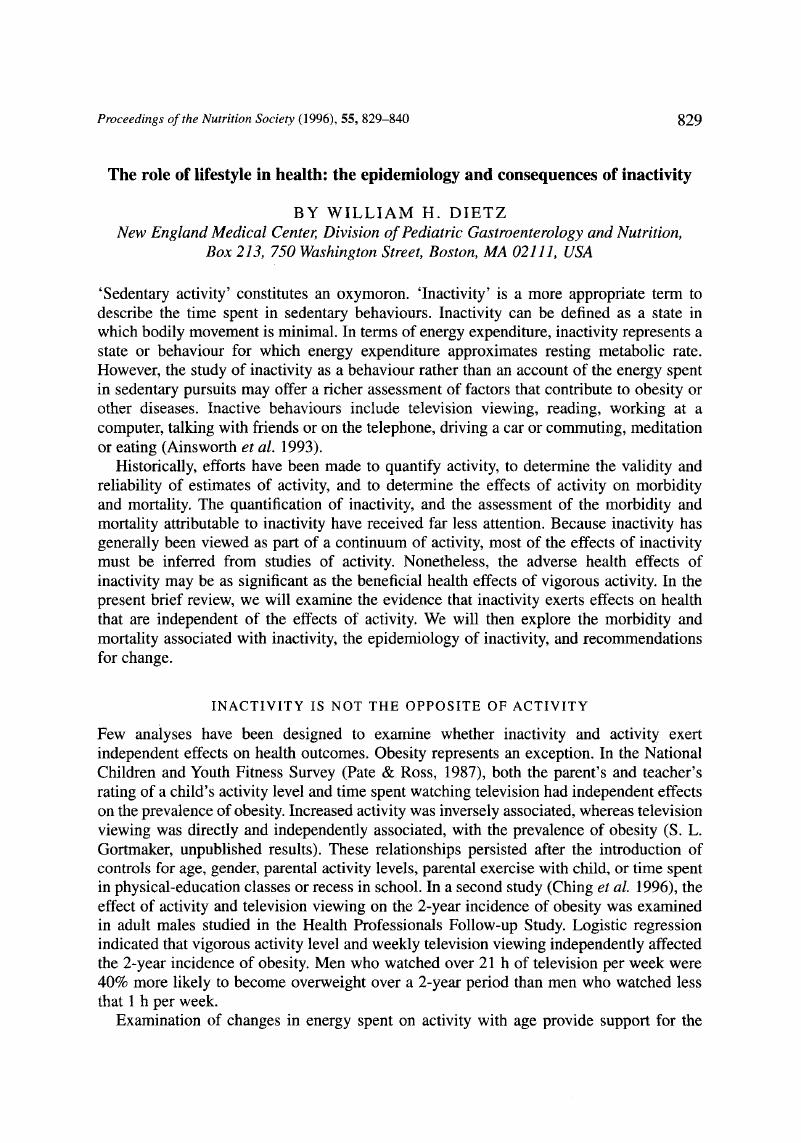Crossref Citations
This article has been cited by the following publications. This list is generated based on data provided by Crossref.
Frelut, ML
and
Jaecques, H
1997.
L'obésité chez l'enfant.
Journal de Pédiatrie et de Puériculture,
Vol. 10,
Issue. 5,
p.
267.
Dunn, Andrea L.
Andersen, Ross E.
and
Jakicic, John M.
1998.
Lifestyle physical activity interventions.
American Journal of Preventive Medicine,
Vol. 15,
Issue. 4,
p.
398.
Gordon-Larsen, Penny
McMurray, Robert G.
and
Popkin, Barry M.
1999.
Adolescent physical activity and inactivity vary by ethnicity: The National Longitudinal Study of Adolescent Health.
The Journal of Pediatrics,
Vol. 135,
Issue. 3,
p.
301.
PRATT, MICHAEL
MACERA, CAROL A.
and
BLANTON, CURTIS
1999.
Levels of physical activity and inactivity in children and adults in the United States: current evidence and research issues.
Medicine & Science in Sports & Exercise,
Vol. 31,
Issue. Supplement 1,
p.
S526.
Harris, H. E.
Ellison, G. T. H.
and
Clement, S.
1999.
Do the psychosocial and behavioral changes that accompany motherhood influence the impact of pregnancy on long-term weight gain'.
Journal of Psychosomatic Obstetrics & Gynecology,
Vol. 20,
Issue. 2,
p.
65.
Vioque, J
Torres, A
and
Quiles, J
2000.
Time spent watching television, sleep duration and obesity in adults living in Valencia, Spain.
International Journal of Obesity,
Vol. 24,
Issue. 12,
p.
1683.
Martinez, J. Alfredo
2000.
Body-weight regulation: causes of obesity.
Proceedings of the Nutrition Society,
Vol. 59,
Issue. 3,
p.
337.
Pomerleau, Joceline
McKee, Martin
Robertson, Aileen
Vaasc, Sirje
Kadziauskiene, Kamelija
Abaravicius, Algis
Bartkeviciute, Roma
Pudule, Iveta
and
Grinberga, Daiga
2000.
Physical Inactivity in the Baltic Countries.
Preventive Medicine,
Vol. 31,
Issue. 6,
p.
665.
Mello, Marco Túlio de
Fernandez, Ana Cláudia
and
Tufik, Sérgio
2000.
Levantamento epidemiológico da prática de atividade física na cidade de São Paulo.
Revista Brasileira de Medicina do Esporte,
Vol. 6,
Issue. 4,
p.
119.
Gordon-Larsen, Penny
McMurray, Robert G.
and
Popkin, Barry M.
2000.
Determinants of Adolescent Physical Activity and Inactivity Patterns.
Pediatrics,
Vol. 105,
Issue. 6,
p.
e83.
Fotheringham, Michael J.
Wonnacott, Rebecca L.
and
Owen, Nevile
2000.
Computer use and physical inactivity in young adults: Public health perils and potentials of new information technologies.
Annals of Behavioral Medicine,
Vol. 22,
Issue. 4,
p.
269.
Florindo, Alex Antonio
Latorre, Maria do Rosário Dias de Oliveira
Tanaka, Tomoe
Jaime, Patrícia Constante
and
Zerbini, Cristiano Augusto de Freitas
2001.
Fatores associados à prática de exercícios físicos em homens voluntários adultos e idosos residentes na Grande São Paulo, Brasil.
Revista Brasileira de Epidemiologia,
Vol. 4,
Issue. 2,
p.
105.
Tudor-Locke, Catrine E.
and
Myers, Anita M.
2001.
Challenges and Opportunities for Measuring Physical Activity in Sedentary Adults.
Sports Medicine,
Vol. 31,
Issue. 2,
p.
91.
Pollard, Tessa M.
2001.
Western Diseases.
Faith, Myles S.
Berman, Nathaniel
Heo, Moonseong
Pietrobelli, Angelo
Gallagher, Dympna
Epstein, Leonard H.
Eiden, Mark T.
and
Allison, David B.
2001.
Effects of Contingent Television on Physical Activity and Television Viewing in Obese Children.
Pediatrics,
Vol. 107,
Issue. 5,
p.
1043.
Gordon‐Larsen, Penny
Adair, Linda S.
and
Popkin, Barry M.
2002.
Ethnic Differences in Physical Activity and Inactivity Patterns and Overweight Status.
Obesity Research,
Vol. 10,
Issue. 3,
p.
141.
Puyau, Maurice R.
Adolph, Anne L.
Vohra, Firoz A.
and
Butte, Nancy F.
2002.
Validation and Calibration of Physical Activity Monitors in Children.
Obesity Research,
Vol. 10,
Issue. 3,
p.
150.
Crawford, David
and
Ball, Kylie
2002.
Behavioural determinants of the obesity epidemic.
Asia Pacific Journal of Clinical Nutrition,
Vol. 11,
Issue. s8,
Reilly, John J.
and
McDowell, Zoe C.
2003.
Physical activity interventions in the prevention and treatment of paediatric obesity: systematic review and critical appraisal.
Proceedings of the Nutrition Society,
Vol. 62,
Issue. 3,
p.
611.
Reilly, John J.
Coyle, Jennifer
Kelly, Louise
Burke, Genevieve
Grant, Stanley
and
Paton, James Y.
2003.
An Objective Method for Measurement of Sedentary Behavior in 3‐ to 4‐Year Olds.
Obesity Research,
Vol. 11,
Issue. 10,
p.
1155.



